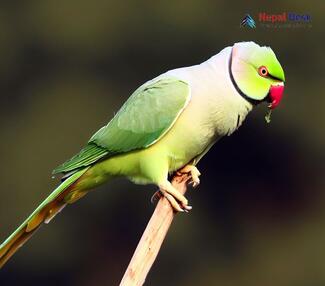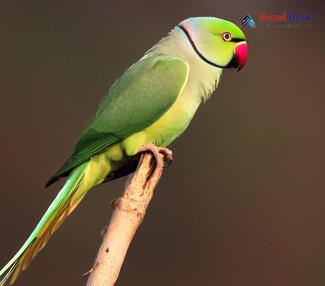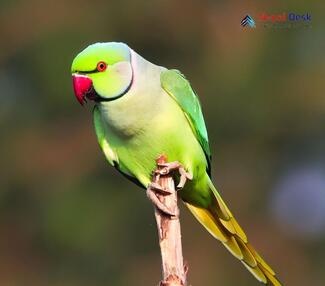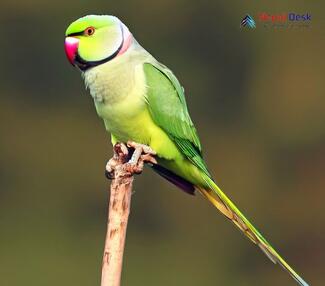The rose-ringed parakeet (Psittacula krameri) is a bird species native to Africa and Asia, identifiable by distinctive plumage and a ringing pattern around its neck. It has a significant global population and a widespread native range across the Indian subcontinent. However, in recent decades it has adapted as an invasive species within new ecosystems.
Nepal represents one environment now increasingly home to introduced rose-ringed parakeet populations that establish long-term residence and breeding colonies. Their complex interactions with native flora and fauna as well as human livelihoods warrant greater research attention.
This species' characteristics as a resilient generalist omnivore allow it to colonize diverse habitats. Evaluating the ecological and social impacts of the species expanding its foothold in Nepal will inform management approaches for this bird alongside native biodiversity preservation. Its unique positioning as both an exotic invader and an alluring aesthetic creature requires nuanced conservation assessments.
Taxonomy and Morphology
The rose-ringed parakeet belongs to the broad Psittaciformes order encompassing all parrots and parakeets.
Its most distinctive feature is the colored neckband that gives the bird its name. The male sports a black throat transitioning into a pale rose or red-colored demarcation across the neck, outlined by a darker red-brown gorget line above with a black lower breastband. The hen's neck rings appear less vivid brownish or grey.
Plumage coloration also varies among four recognized subspecies across native ranges from Sub-Saharan Africa through southern Asia. Overall the birds display green wings and tails with a lighter yellowish-green underbody, a pointed black beak for cracking seeds and nuts, and long tapered tail feathers.
They reach 35-43cm body size on average with a 50cm wingspan and weight up to 150g depending on sex and subspecies. The Sri Lankan race averages smaller while African subspecies are larger-bodied. Compared to related parakeets it has the longest tail-to-body proportion.
Distribution in Nepal
In Nepal, rose-ringed parakeets reside across the Terai, Siwalik, and Middle Hills regions up to approximate elevations of 1,000 meters. They frequent subtropical lowlands to foothills, inhabiting forest edges, woodlands, and agricultural areas ranging from rice paddies to orchards and gardens near human-developed zones.
The highest population densities occur around Nepal's central and western Terai districts like Rupandehi, Kapilvastu, and Nawalparasi with the availability of nest sites and abundant food sources. However, their numbers seem sparse in high-elevation valleys of mountain districts while absent from alpine zones above treeline.
National-level survey data indicates rapid growth from an estimated 6,500 individuals around the year 2000 to over 50,000 by 2015. Researchers partially attribute spiking numbers to reduced competition from vulture populations whose rapid declines left vacant feeding niches. Their ability to exploit human-altered environments also facilitates expansion.
This non-migratory species is capable of making seasonal movements based on resource availability, particularly food. Some local upward shifts from lowland areas towards foothills can occur post-monsoon and in winter associated with ripening grain crops and fruiting trees at different altitudes. However detailed accounts of movement ecology within Nepal remain lacking in literature.
Behavior and Ecology
Rose-ringed parakeets display flexible, opportunistic feeding behaviors across seasons. Their predominantly herbivorous diet comprises seeds, buds, flowers, and fruit from crops like mustard and paddy rice as well as native and non-native plants. Supplementing with occasional insects and nestlings makes them adaptable generalists.
The breeding season lasts from December through June, motivated by resource availability. Nests occur in tree hollows up to 30 meters high on spreading canopy branches. Clutch size ranges from 2-5 eggs. Both sexes incubate eggs and care for subsequent fledglings. This facilitates higher breeding success.
Outside breeding periods, rose-ringed parakeets maintain complex social structures living in large, noisy communal roosts and foraging flocks. Their communication repertoire features an array of contact calls, alarm cries, feather displays and in-flight signals. Roosting groups may intermingle with other native parakeet species.
Interactions with Nepal’s threatened green-billed malkoha through niche competition are raising concerns. However, rose-rings occupy a somewhat separate feeding niche being mainly herbivorous. Still, aggressive eviction of native fauna from nest sites earmarked for conservation merits mitigation considerations.
Detailed analysis of inter and intra-species dynamics will determine this parakeet’s level of threat to ecological stability. Their overall resilience poses difficulties in managing spread once entrenched.
Human-Parakeet Interactions
With rose-ring parakeet populations soaring, interactions with humans and economic activities are intensifying. As opportunist feeders, the birds damage ripening cereal crops like rice, maize, and wheat across districts like eastern Chitwan. Estimated losses reach up to 30% for select grain varieties. This aggravates rural farmers' struggles.
However, the birds find cultural admiration for their vocality and plumage. The Mewahang Rai ethnic group considers the parakeet a seasonal indicator signaling plantation timing through arrival patterns. Local names like "mauso-ringneck" reveal integrated identities within villages. Yet nuisance factors spur conflict.
Urban green spaces host flocks drawn to exotic flowering trees. Their loud calls, mess, and aggressive squabbles over nest cavities strain public tolerance as cities expand. Reports near Kathmandu detail dive-bombing pedestrians for amusement as the species shows little intrinsic fear towards humans.
Addressing threats to agriculture and ecosystems from this exotic parakeet requires carefully weighted action. Removal methods risk inadvertent capture of native species with similar profiles. Temporary non-lethal deterrents balance human interests while upholding welfare ethics and conservation obligations
Managing sustainable coexistence relies on locating population thresholds before overriding competition disrupts ecological balance. meanwhile balancing cultural appreciation with economic protection channels the complex realities underlying biodiversity management.
Conservation Status
While thriving across native and introduced ranges, localized threats to rose-ringed parakeets exist in Nepal. Trade-driven poaching for the exotic pet industry illegally exports wild caught fledglings abroad despite bans. Habitat loss also affects breeding and foraging resources.
However, Nepal lacks targeted action plans for this species given stable global populations are categorized as "Least Concern" on the IUCN Red List. Negative impacts on crops and possible competition with protected species also complicate universal conservation advocacy.
Still, promoting responsible ownership of captive-bred birds could lower illicit capture from the wild. Protecting old-growth tree stands and regenerating forest areas maintains nesting options. Limiting pesticide usage in adjacent farmlands reduces toxicity exposure risks.
General provisions under Nepal's National Parks and Wildlife Conservation Act protect all birds. But policy primarily focuses on vulnerable endemic species while designating some prolific generalists as "pests". Conflict arises over appropriate legal protections for introduced birds that prove detrimental yet remain deeply entrenched.
Integrated management requires updated ecological data and multi-stakeholder consensus. Without context-specific sustainable solutions balancing conservation ethics and livelihood protections, consequences may compound for agriculture and ecosystems as the species adapts and spreads.
Research and Study
Research on invasive rose-ringed parakeets in Nepal emerged over the past decade, correlating population spikes with intensified conflict. Early studies focused on distribution surveys, crop damage assessments, and impacts on protected Malkoha habitats. This baseline data established an imperative for applied management guidance.
Ongoing tracking initiatives monitor urban adaptations, with Kathmandu-based efforts combining GPS transmitters on captive birds and citizen science nest reports. International collaborations facilitate technology access and resource networks to elevate local capacity. Similar rural projects document seasonal movements and agro-ecological relationships shaping farmer attitudes.
These targeted studies offer models to conduct context-specific research on resilient invasive species. Quantifying population densities, environmental impacts, and shifting human responses creates an evidence base for practical conservation strategies that balance ecology, ethics, and livelihoods.
Nepal's projects thus contribute to wider avian sciences understanding the drivers and managing outcomes of biological invasions. This interdisciplinary approach integrating geospatial data, genetic analysis, anthropological surveys, and threat modeling leads to globally relevant insights. As climate change accelerates ecosystem changes enabling introductions, transferable mitigation frameworks developed in Nepal could guide invasive species management elsewhere.
Role in Ecosystem
As an omnivorous generalist species with high reproductive success in diverse habitats, the rose-ringed parakeet exerts a growing influence on forest ecosystems and crop systems across Nepal's lowlands. Quantifying impacts on native biodiversity and ecological relationships remains vital for a balanced assessment.
Observations detail the eviction of threatened bat and bird species from tree hollow nest sites needed for breeding and shelter. Competitive exclusion jeopardizes endangered Malkohas reliant on such safe cavities. Surveys of vacated areas however show mixed declines and rebounds from original inhabitants warranting further population tracking.
Meanwhile, their frugivorous appetite boosts seed dispersal quantities for both native plants like Thunbergia orchids and invasive pioneer species such as Leucaena leucocephala now common along forest edges. This dichotomous role is Less certain is the net impact from extra dispersion balanced against nest competition regarding ecosystem stability.
Ecological consequences likely depend on context-specific densities, velocities of change, ratios of generalist populations balanced against forest specialists, and lags measuring long-term habitat structure changes following introductions. More robust field evidence painting local pictures can best advise regional management plans addressing invasive species modeled after those developed for Nepal's complex but increasingly prevalent rose-ringed parakeets.
Importance in Aviculture
Beyond ecology, the rose-ringed parakeet holds value for aviculture (bird breeding). Their vocal talents, trainability, and attractive colors make them immensely popular cage birds globally. Particularly in Europe, the USA, Japan, and the Gulf States, high demand drives international trade.
Their ready breeding in captivity supports commercial-scale production more sustainably than reliance on wild capture. Breeders focus on selecting traits like body size, bright plumage patterns, and temperament. Hand rearing from eggs allows birds to imprint early on humans. Husbandry techniques aim to stimulate breeding through environmental cues, supplements, and nest box arrangements facilitating egg lay and rearing.
Nepal recently emerged as an exporter of captive-bred stock amidst stricter regulations on wild bird trade. The development of agricultural networks located for this prolific parakeet aligns economic incentives with conservation ethics regarding the sustainable use of natural resources.
However, confusion around the permissible take and sale of eggs or fledglings from the wild persists among Nepal’s grassroots traders and trappers. Clarifying legal channels while building best practice knowledge for captive breeding enterprises promotes the welfare of both birds and the humans caring for them within a biodiversity-friendly, culturally relevant model.
Future Prospects and Challenges
Climate change looms as a catalyst that may exacerbate invasive threats from rose-ringed parakeets across Nepal. Warming trends allowing tropical species to persist and reproduce at higher altitudes could vastly expand habitat vulnerability. Conservationists recommend predictive models map future suitability to target proactive management.
Developing strategic coexistence relies on agroforestry methods like altering crop cycles, intercropping with less palatable plants as sacrificial buffer zones, and boosting nest boxes for native species. Community stewardship of ecosystem balance can mitigate conflict from damage or competition amidst flux.
Critical research needs to entail projecting ecological impacts under environmental change scenarios to implement location-specific goals preventing overpopulation in sensitive zones. Quantifying tipping points where introduced species override ecosystem renewal rates informs control decisions respecting welfare ethics. Meanwhile, consistent monitoring offers early intervention opportunities to curb fast-establishing species.
By pairing cooperation strategies embracing shared habitats with continuous science illuminating sustainable boundaries, communities can proactively steward inevitable adaptions from species like parakeets. Their enduring vibrance as introduced inhabitants creates space for inclusive conservation reconciling economic and intrinsic values.
Conclusion
In summary, the rose-ringed parakeet exemplifies the contemporary challenges of alien invasive species establishing alongside human population centers drawn to similar resources. As an adaptable generalist, it occupies flexible niches across Nepal's grasslands and orchards, demonstrating traits that hasten spread even amidst unknown equilibrium impacts.
These birds walk an uneasy line - appreciated for familiarity yet culpable for economic and ecological harm. Their legal protection status remains difficult to boundary without reliable population data determining tipping points. Their ambiguous positioning illuminates complexities inherent to managing biodiversity flux shaped by both climate and human forces.
Going forward the need for evidence-based, location-specific recommendations is urgent as changes accelerate. Their tenacity befits a survivor but solidarity with local farmers and conservation objectives relies on updated science exploring boundary thresholds. In navigating extremes, the parakeets encapsulate wider struggles to understand newcomers before judging welcome. Their future in Nepal symbolizes the future of integrated conservation as well.




